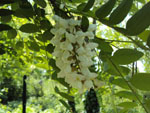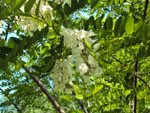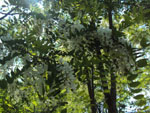The robinier (commonly referred to as "falsacia" or "acacia")
|
|
This tree, originally from Canada, arrived in France in the 17th century and owes its name to the brothers Robiniers, gardeners of the King. The first naturalists have observed the tree wrongly assimilated to an acacia of Africa, hence the fact that it is often called “acacia”.
The flowers, in spring, can eat raw, in reasonable quantity. Eat too much causes nausea.
They also serve in dignets or in pancakes. They have a taste and a smell that reminds the orange blossom. |
| |
|
 |
|

|
Beignets:
Ingredients for about 6 pers:
150g of flour
1 egg
salt
1cs of alcohol
1dl milk
1⁄2 packet of yeast
a little sugar to sprinkle the doughnuts
Preparation:
Let the dough rest for 2 hours.
When the dough is rested, dip the flowers in it holding them by the tail and throw them in the hot oil. Prefer a pan on high edges or a pot, or a fryer, for splashes.
When golden, pull them out and put them on an absorbent paper and cover them with powdered sugar.
|
| |
|
|

|
Jelly with robin flowers:
Ingredients:
100g of robin flower petals, 1l of water, 500 to 750g of cane red sugar, lemon, agar-agar.
Preparation:
Put the petals in the water and cook with a small broth for 25 min. Prepare the agar.
Filter the juice and add the sugar and agar preparation. Let cook again 3 or 4 min. Then put in potty, and leave them potties cool the lid down to hunt the air. Finally, you can return them potties and wait a few days before tasting.
|




